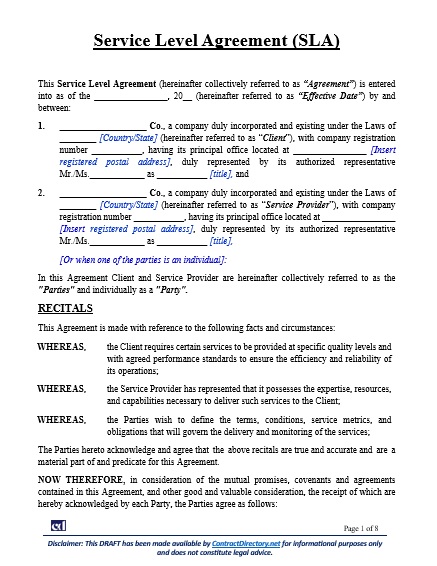A Service Level Agreement (SLA) defines the exact performance standards, availability targets, and responsibilities between a client and a service provider. Unlike a standard service contract, an SLA is performance-driven—it sets measurable benchmarks such as uptime percentage, response time, and resolution time. These terms ensure that both parties understand not only what services will be delivered but also how well they must perform.
An SLA typically outlines service definitions, scope of work, metrics, reporting obligations, service credits, and remedies in case of non-compliance. It also contains detailed clauses for dispute resolution, confidentiality, force majeure, and governing law to safeguard both sides in complex business relationships. For technology providers, data centers, managed IT services, and telecommunications companies, an SLA is the backbone of operational accountability and customer trust.

Difference Between a Service Agreement and a Service Level Agreement
A Service Agreement establishes the overall legal framework for the provision of services—it covers commercial terms such as payment, duration, termination, warranties, and liabilities. It defines what services are to be provided and on what conditions.
By contrast, a Service Level Agreement (SLA) focuses on the quality and performance of those services. It acts as a supplement or annex to the Service Agreement, adding measurable standards—such as uptime, response rates, and issue-resolution timelines—that determine whether the provider has fulfilled its contractual duty. In essence, the Service Agreement forms the “contract,” while the SLA provides the “metrics.”
Why SLAs Matter in Modern Contracts
Today’s enterprises rely heavily on consistent service quality. SLAs protect clients by enforcing measurable obligations and empower providers to demonstrate reliability. When properly drafted, they prevent misunderstandings, improve efficiency, and reduce disputes—turning service delivery into a transparent, quantifiable partnership.
References
- ITIL Foundation. Service Level Management Practices.
- ISO/IEC 20000-1:2018. Information Technology – Service Management System Requirements.
- European Commission Digital Strategy. Service Level Agreements in Cloud Computing Contracts.
- U.S. General Services Administration. Technology Service Level Agreements – Best Practices.
- Gartner Research. How to Structure Effective SLAs for Managed Services.
.
Related Topics:
#ContractManagement #ServiceAgreement #LegalTemplates #SLA #BusinessContracts #ContractDirectoryNet
has been added to your cart!
have been added to your cart!



